Porto-North-Portugal.com
The best independent guide to the Douro
Porto-North-Portugal.com
The best independent guide to the Douro
The Linha do Douro Railway; a tourism guide to the Porto to Douro Valley train for 2025
The Linha do Douro is one of Europe's most scenic railways which winds alongside the mighty Douro River for over 160km from Porto in the west to Pocinho in the Alto Douro region.
For much of the journey, the train follows the river's meandering course through the heart of Portugal's wine-growing region, passing picturesque terraced vineyards and traditional quintas (wine estates).
The Linha do Douro can be enjoyed as a day trip from Porto, with stops possible at the historic riverside towns or at the quintas for wine tasting and tours. This guide will help you get the most from the Linha do Douro railway by suggesting day tours and details of the towns that can be visited along the route.
Related articles: Guide to the Douro - Douro by car - Porto day trips
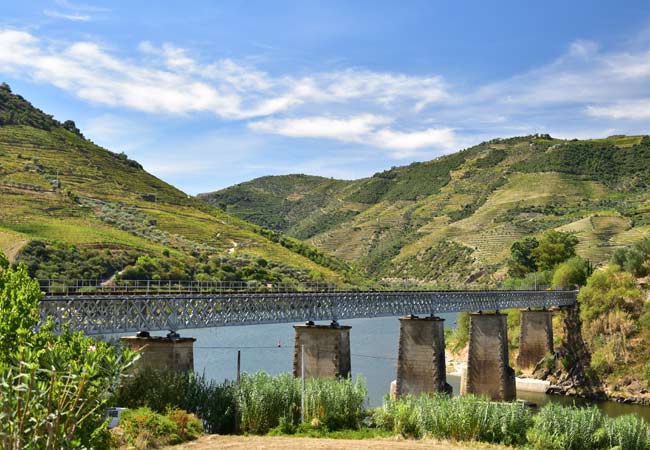
The Linha do Douro railway as it follows the river upstream
Why explore the Douro Valley by train?
The Linha do Douro railway is one of the best ways to explore the Douro Valley and is recommended for independent or budget-conscious visitors. The key advantages over taking a boat cruise from Porto or self-driving are:
• Speed and coverage: The train is significantly faster than a boat cruise, allowing you to see more of the stunning Cima Corgo region during a day trip
• Freedom to wine taste: Everyone in your group can fully enjoy wine tasting sessions without concerns about driving. Never drink and drive.
• Cost-effective: A train day trip is considerably cheaper than taking a boat cruise, a car, or joining an organised tour.
• Flexibility: The train allows you to plan your own schedule and explore at your own pace, unlike the full day boat tours, which can feel restrictive.
It should be noted that the first hour of the journey from Porto passes through nondescript towns and countryside. The railway only joins the scenic Douro River at Pala, from where it follows the beautiful river valley all the way to Pocinho.
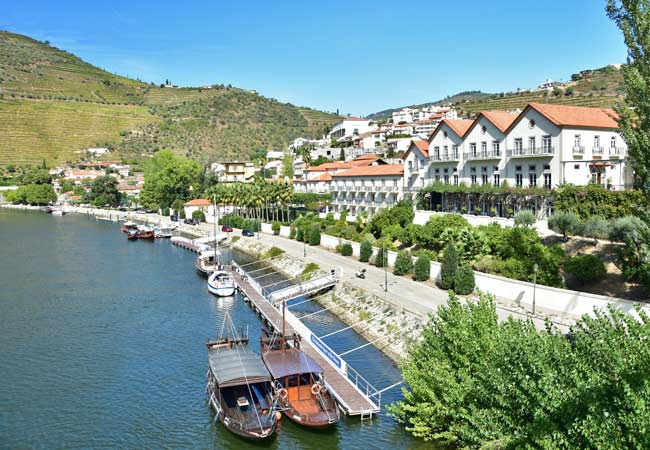
The pretty town of Pinhão on the banks of the Douro
Suggested ideas for day trip to the Douro Valley and the Linha do Douro
A day trip along the Linha do Douro is not just sitting on the train but can be an opportunity to explore the region. Suggested ideas are:
• Ride the entire Linha do Douro.
Take the train to the easternmost station at Pocinho, which allows you to experience the entire Linha do Douro railway line. There are few tourist sites at Pocinho, so most visitors hop on the train for the return journey. This could be a good choice during poor weather (such as the winter rains) or if you prefer a relaxing day after all the walking in Porto.
Riding the entire Linha do Douro does involve significant time on the train, as the direct service takes 3 hours and 20 minutes to travel from Porto to Pocinho. If you prefer this relaxing option, the direct daily departures leave Porto São Bento at 09:20 and 13:20.
• Ride the train to Pinhão and explore local attractions.
Pinhão is the most picturesque town in the Douro Valley and offers several engaging activities. While here, you could join a one-hour boat trip along the river or hike the 2.5km trail up to the stunning Casal de Loivos viewpoint. If you prefer wine tasting and tours, the Quinta do Bomfim, Quinta das Carvalhas and Quinta da Roêda are all within walking distance (advance bookings may be required). Pinhão is small but a lovely place to spend a few hours. The train takes 2 hours and 20 minutes to reach Pinhão from Porto.
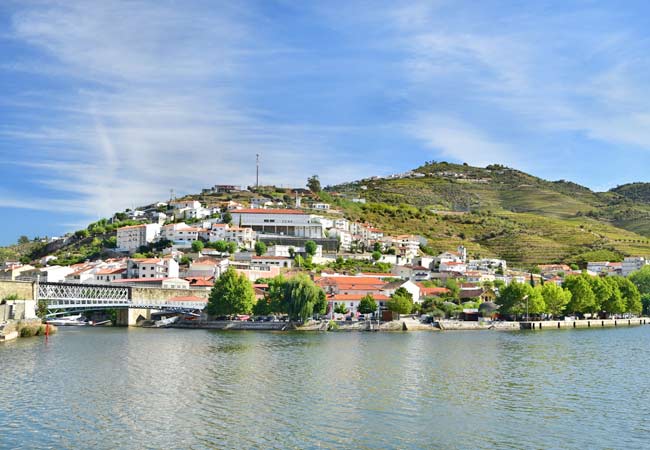
• Ride the train to Peso da Régua for a river cruise.
Peso da Régua (commonly known as Régua) is the largest town in the Douro Valley. It serves as the main departure point for boat cruises and is the location of the excellent Museu do Douro. From Régua, numerous boat cruises travel upriver to Pinhão and back to Régua, making this the ideal choice if you want to focus on a river experience. The train takes 1 hour and 50 minutes to travel from Porto to Régua.
Insider tip: Régua is actually the best starting point for any Douro boat cruise, as it bypasses the less scenic sections of the Baixo Corgo near Porto, letting you focus on the most dramatic stretches of the river valley.
• Ride the train to Pinhão (ideal for poor weather)
The section of Linha do Douro and Douro River between Régua and Pinhão is the most spectacular of the entire route. Taking the train to Pinhão and catching the first return service to Porto makes an excellent half-day excursion. This is particularly suitable for days with poor weather or if you are limited for time.
Do note: Check the return train timetables before choosing this option (detailed schedules are provided later in this guide), as there can be lengthy waiting times at Pinhão between services.
• Combine Pinhão and Régua
Ride the train to Pinhão to explore the charming riverside town, then continue to Régua for the fascinating Museu do Douro and a wine tasting session. This option is the best if you want to get the most from your day of sightseeing.
Insider tip: Plan to end your day in Régua rather than Pinhão, as Régua offers more frequent return trains to Porto. This will give you greater flexibility with your schedule and avoiding potentially long waits for connections.
• Combine Régua and Lamego
Just a short journey south of Régua lies Lamego, a delightful town known for the magnificent Nossa Senhora dos Remédios church and baroque stairway. This combination of destinations makes an enjoyable alternative if you are less interested in wine tasting or river cruises.
Insight: Regular buses connect Régua to Lamego, or you can easily take an Uber/Bolt or taxi.
The interactive map below displays the route of the Linha do Douro railway. The map shows all the stations along the river valley with green markers green, and the main stations of interest to visitors (Régua, Pinhão, and Pocinho) are marked in yellow. (Note: Zoom out to see all the points)
Stations along the Linha do Douro: 1) Pala 2) Mosteirô 3) Aregos 4) Mirão 5) Ermida 6) Porto de Rei 7) Barqueiros 8) Rede 9) Caldas de Moledo 10) Godim 11) Régua 12) Covelinhas 13) Ferrão 14) Pinhão 15) Tua 16) Alegria 17) Ferradosa 18) Vargelas 19) Vesúvio 20) Freixo de Numão 21) Pocinho
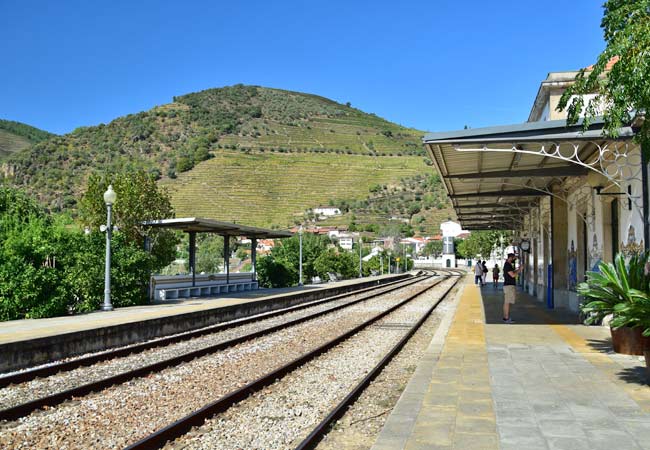
Train times, fares and practical information
The Linha do Douro train service is operated by Comboios de Portugal (CP), the national rail company of Portugal. A summary of journey times and fares is shown below:
Porto São Bento to Pocinho
Inter-Regional (IR): €14.50 single / €26.10 return
Journey time: 3 hours 20 minutes
Porto São Bento to Pinhão
Inter-Regional (IR): €11.95 single / €21.50 return
Journey time: 2 hours 20 minutes
Porto São Bento to Régua
Inter-Regional (IR): €10.65 single / €19.17 return (1 hour 50 minutes)
Regional (R): €8.35 single / €15.00 return (2 hours)
The return prices are approximate as a 10% discount is applied to return tickets. These times shown are for the fastest available services.
The complex timetable can be seen on the Comboios de Portugal website in the link below. The timetable is complex due to various train types, departure locations, connections and differences at weekends or public holidays.
For any trip along the Linha do Douro we recommend catching the 9:20 Inter Regional (IR) service from Porto São Bento. This train is a direct service all the way through to Pocinho, departs from the central “São Bento” train station and is a fast service, with minimal stops. The 13:20 from São Bento is a good option for a shorter half day tour, especially if you only want to go to Régua or Pinhão.
www.cp.pt/
The above link is a PDF so it may download on certain phones.
Porto has two train stations São Bento and Campanhã. São Bento station lies within Porto's historic centre, while Campanhã station is situated 2km to the east. Although Campanhã serves as Porto's main rail hub with connections to the north-south express network, most visitors choose to depart from São Bento due to its central location.
The Comboios de Portugal website (CP.PT) features a journey planner where you can search for trains. When planning your journey, check whether the service requires connections, note the train type (IR or R), and verify the departure/return station in Porto (São Bento or Campanhã).
Tickets for Inter Regional trains can be purchased from the CP website, but you may be required to put passport details in. Often it is easier to purchase the tickets from the train station before the train journey. On IR train services seats are not reserved, so there is no advantage of booking your tickets days in advance, it is much better to turn up early and get a window seat.
Insight: There are many third-party websites that sell Portuguese train tickets. It is always better to book direct on the CP websites (or at the train station) as fares will be lower and there will be no booking fees. Also buying from third party websites can cause problems if you miss a train or there are cancellations.
Comboios de Portugal offers discounts for various age groups across their train services. Children aged between 4 and 12 can travel for half price, while young people aged 13 to 25 receive a 25% reduction on their fares. Senior citizens aged 65 and above also benefit from a 50% discount. To take advantage of these discounts, passengers must carry valid proof of age.
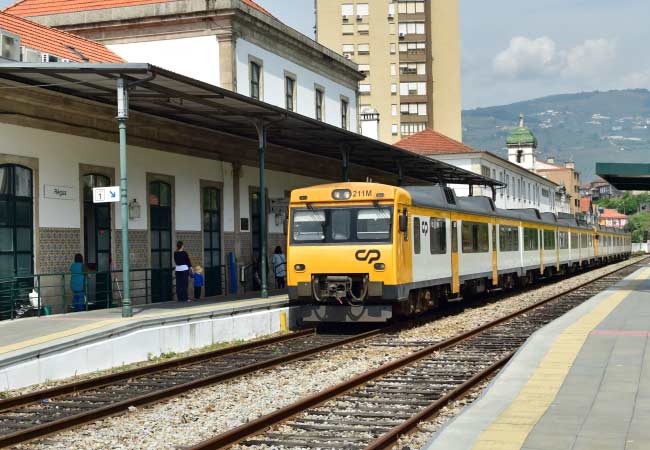
Tours of the Douro Valley
An organised tour led by an experienced guide is often the best way to get the most from the Douro region. There are many excellent tours that combine wine tasting, a boat cruise and sightseeing in a single day. Some of the best tours offered by GetYourGuide include:

Pocinho - end of the line...
Towns along the Linha do Douro
Peso da Régua
Peso da Régua was historically the heart of Port wine trade, and sits strategically on the Douro River's south bank. In the 18th century, it became the collection point where barrels of wine were loaded onto the traditional Rabelo boats for their journey to Vila Nova de Gaia. This role made Régua the headquarters of the Real Companhia Velha, which regulated Port wine production under royal charter.
Today, the impressive Museu do Douro, housed in a restored 18th-century mansion, tells the region's rich wine-making history through interactive exhibits and a significant archive. The museum's rooftop offers panoramic views of the river valley.
The town serves as a major transportation hub, with regular boat tours departing from its riverside quay and trains connecting Porto to the upper Douro. While its waterfront promenade provides pleasant river views, Régua is primarily a working town rather than a tourist destination. The nearby Solar do Vinho do Porto offers guided Port wine tastings, representing wines from across the region.
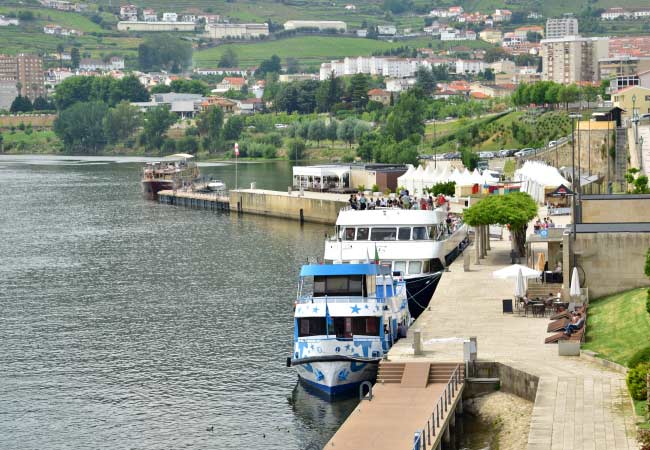
Many visitors start their boat tour from Peso da Régua
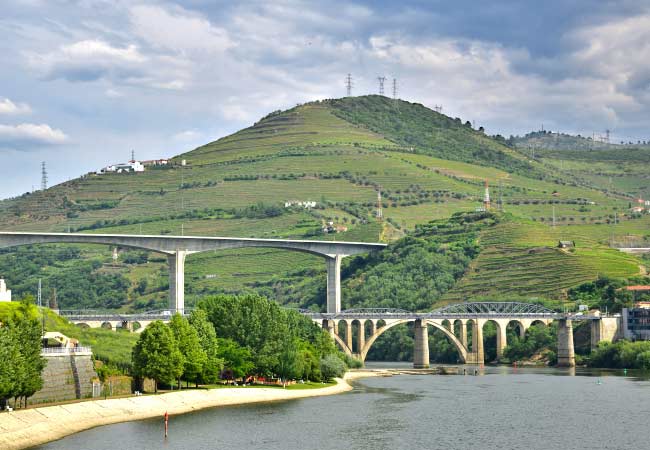
The three bridges of Peso da Régua
Pinhão
Pinhão is the quintessential Douro Valley town, widely considered the geographical heart of the port wine-producing region. This delightful town of around 3,000 inhabitants is surrounded by hills lined with vineyard terraces and sits on a major bend in the Douro River, approximately 25km upstream from Peso da Régua.
The town's historic railway station, built in 1937, is one of Portugal's most beautiful and serves as a major tourist attraction. Its walls feature 24 stunning azulejo panels (traditional blue and white painted tiles) created by Jorge Colaço, depicting traditional scenes of vine growing and wine production in the Douro.
Several wine estates (quintas) are located within walking distance of Pinhão offering tours of their estates and tasting sessions. They are:
• Quinta do Bomfim (owned by Symington Family/Graham's Port)
• Quinta das Carvalhas
• Quinta do Noval
The town's waterfront, known as the cais, offers various boat tours ranging from one-hour trips to full-day cruises. If you're feeling energetic you could follow the 2.5km hiking trail up the hill behind Pinhão to the Miradouro Casal De Loivos, one of the finest viewpoints of the Douro region.
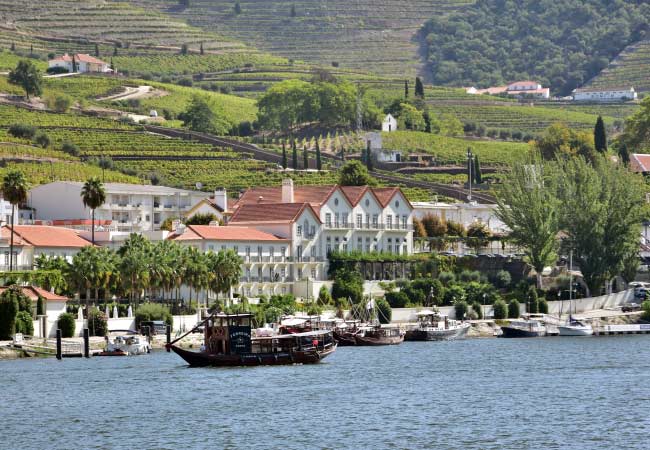
Pinhão riverside with traditional boats ready for tourist cruises
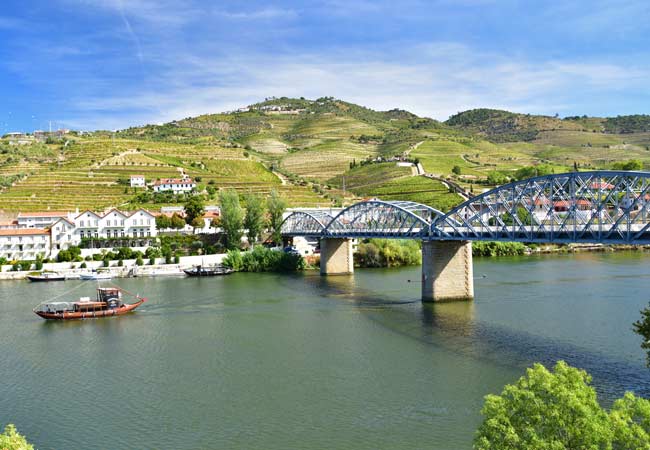
The Ponte do Pinhão bridge spanning the Douro River
Tua
Tua is a peaceful village in the upper Douro and sits at the confluence of the Tua and Douro rivers. The village is primarily known for its historic railway junction, where the Linha do Tua once branched northward from the main Douro line.
The station complex, larger than the village might suggest, includes a small museum documenting the railway's history. A scenic riverside path leads to the Foz Tua Dam, completed in 2017. This controversial project submerged sections of the historic Tua Valley railway line, which had operated since 1887 and was renowned for its dramatic journey through steep gorges to Mirandela.
The surrounding area provides excellent hiking opportunities through traditional vineyard terraces and olive groves. The microclimate here, where the two rivers meet, creates unique conditions that local wine producers have exploited for generations. During spring, the hillsides are particularly beautiful when the almond trees bloom.

The Linha do Douro crossing the Tua River, as it joins the Douro
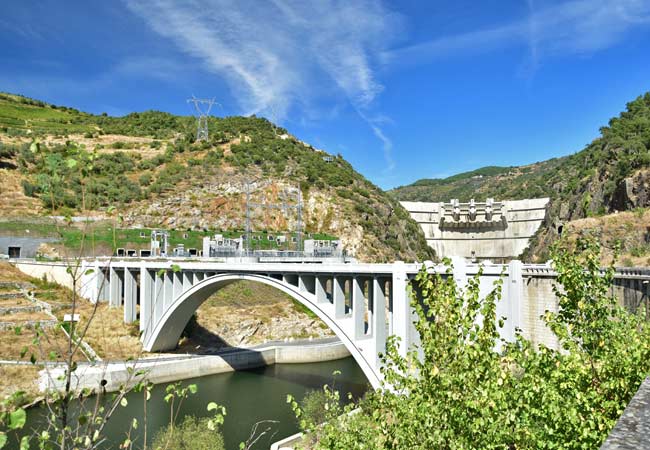
The Tua dam and the bridge into the town
Pocinho - end of the railway
Pocinho is the terminus of the Linha do Douro and embodies the atmosphere of an end-of-the-line station. The village has a semi-industrial character, marked by power lines from the impressive Pocinho Dam (completed 1983) and an abandoned railway bridge that once carried the narrow-gauge Linha do Sabor to Miranda do Douro.
Pocinho lies within the parched upper Douro region known as Terra Quente (hot earth), where summer temperatures regularly exceed 40°C. The harsh climate and rugged terrain that make life challenging here are the same conditions that produce the region's renowned Port wine grapes. The surrounding landscape offers dramatic views of steep terraced vineyards within the UNESCO-listed Alto Douro Wine Region.
The station building itself is notable for its size and traditional yellow-painted walls adorned with azulejo tiles, reflecting its historic importance as a junction where rail and river transport met.
For day-trippers, while there's little to see in Pocinho itself, the journey here offers spectacular views of the Douro Valley.
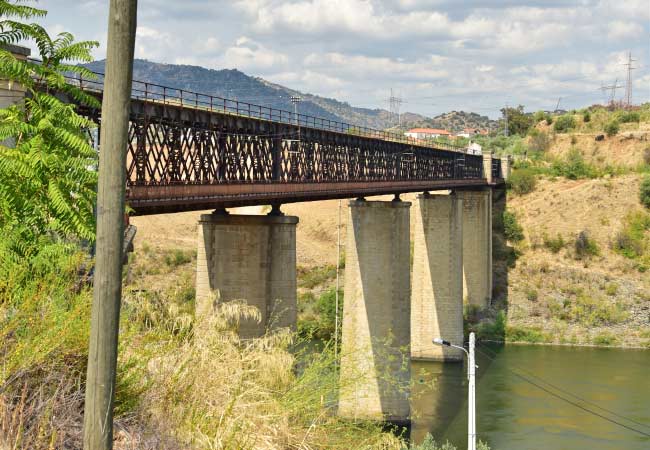
The Linha do Sabor used to head north from Pocinho, and all that remains is the rusting bridge (the Ponte do Pocinho)
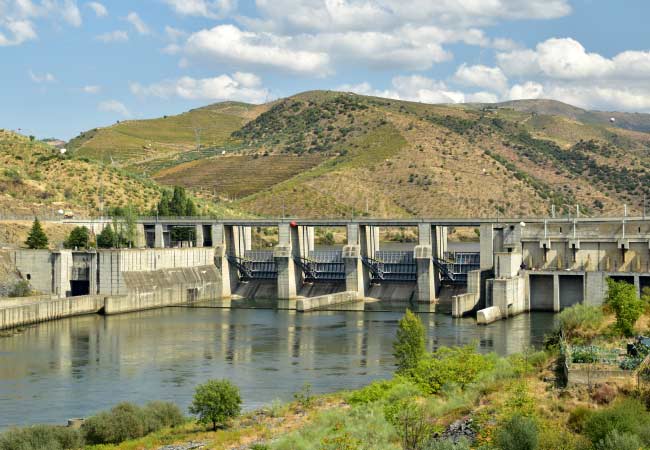
Pocinho dam is not as scenic as other areas along the Douro, with a massive transformer station on the northern banks
Vale do Côa
Just 4km south of Pocinho lies the arid Vale do Côa, home to one of the world's most important open-air Paleolithic rock art sites. This UNESCO World Heritage site features thousands of engravings dating from 22,000 to 10,000 years ago, depicting horses, aurochs, and other Ice Age wildlife. The artwork's discovery in the 1990s led to the cancellation of a planned dam, preserving this extraordinary prehistoric gallery for future generations.
The ultra-modern Museu do Côa in Vila Nova de Foz Côa provides excellent context through interactive exhibits and 3D reproductions. To view the actual rock art sites, visitors must book guided tours through the Parque Arqueológico do Vale do Côa. Tours operate day and night (night tours use special lighting), and advance booking is essential.
While local taxis can reach the museum, exploring the wider Vale do Côa and upper Douro region effectively requires a rental car.
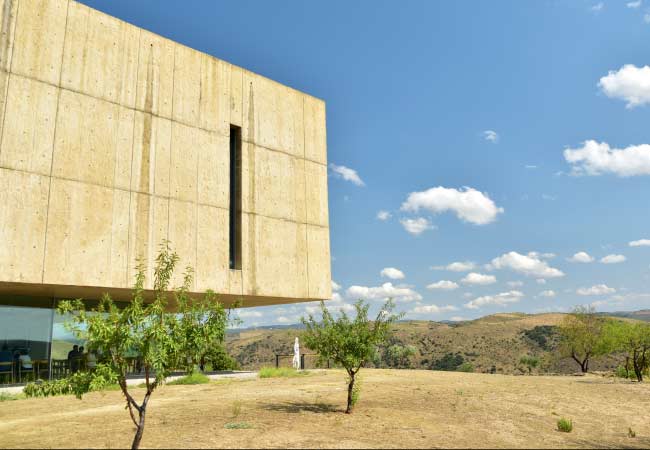
Parque Arqueológico do Vale do Côa
Mesão Frio
Mesão Frio sits dramatically on a bend in the Douro River, marking the traditional entrance to the Alto Douro wine region proper. The town's name, meaning "cold table," refers to its unique microclimate - despite being in wine country, it's notably cooler than surrounding areas due to its elevation and exposure to Atlantic influences.
Historically, Mesão Frio played an important role in river navigation - its position at a challenging bend in the river made it a natural stopping point for rabelo boats carrying wine barrels downstream to Porto. Today, while smaller than Régua or Pinhão, it remains an authentic working wine town, less touched by tourism than its more famous neighbors.
The town's most distinctive landmark is the baroque Igreja de São Nicolau (Church of Saint Nicholas), with its prominent twin towers visible from the river.
São João da Pesqueira
São João da Pesqueira is one of the oldest wine-producing settlements in the Douro region, sits atop a plateau overlooking the river. The town's name "Pesqueira" refers to ancient fishing weirs once used in the Douro River before the dams were built.
The historic center preserves significant medieval elements, including parts of its original walls and the Porta do Sol, a 16th-century gate that was once the main entrance to the town. The central square (Praça da República) is a well-preserved example of baroque urban planning, featuring the distinctive Town Hall with its traditional arches.
The town played a crucial role in Port wine history - it was one of the first areas to be officially designated for Port wine production in 1756, when the Marquis of Pombal established the world's first protected wine region system.
If you've found our content valuable, we'd welcome your support.
The digital publishing landscape has evolved significantly. As a small independent publisher, we face growing challenges. Search engines increasingly favour paid content over organic results, while AI-generated content often reproduces original work without attribution.
To support our work, please consider bookmarking this page (press Ctrl + D) for quick access. If you find an article helpful, we'd be grateful if you'd share it with friends on social media.
For specific questions, please see our Reddit community at r/LisbonPortugalTravel.
Should you notice any outdated or incorrect information, please contact us at [email protected]
Thank you for helping us continue to provide valuable content in an increasingly challenging digital environment.



















